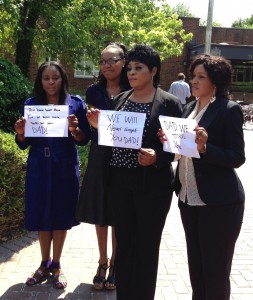JUSTICE FOR MUHAMMED SILLAH — CAMPAIGN
Prominent political activist, Muhammed Sillah was slated for deportation to the Gambia where he fears for his life because of his outspoken activism. Community pressure stopped his deportation on June 11th, yet today, a month later, he is still in detention and facing racist abuse.
In retaliation for protests and actions in his support, the Canada Border Services Agency (CBSA) refuses to let Muhammed Sillah rejoin his family, despite a Federal Court ruling insisting that he be able to contact a lawyer and file new applications for his stay.
Not only has CBSA put up obstacles in front of Muhammad’s release, they and their private prison profiteers G4S use racist slurs against him, denying him basic rights and have refused to let his wife visit him.
Sign, share, and tweet this petition! Demand that Muhammed Sillah be released and the racist CBSA officers be held to account: http://www.change.org/en-CA/petitions/cbsa-what-your-mom-doesn-t-cook-yo…
Since June 5th, CBSA has refused to let Mr Sillah’s wife visit him – in fact they have refused to let her on to the government property or allowed her to drop him clothes. This is entirely because of her activism to stop Mr Sillah’s removal. See details of the campaign, and videos at www.facebook.com/JusticeForMuhammed
The Canada Borders Services Agency and G4S have racially targeted and abused Muhammed since his arrest. There are numerous examples but here are two instances his family has shared:
** When Muhammed was first arrested, CBSA officer Mr. Ivory said to him: “Why don’t you have your family do black magic to stop your removal?”
** Muhammed had bugs in his food while in immigration detention, when he complained he was told: “What, your Mom doesn’t cook you bugs in Africa?”
Mr Muhammed Sillah was diagnosed with a heart murmur in 2006. He has had high blood pressure since he was arrested and has been vomiting after many meals. He has received no adequate medical attention.
His continued detention is unjust, the attacks against him and his family are nothing but targeted harassment and part of an immigration detention system is racist and exclusionary.
Sign this petition! Demand justice and status for Muhammed Sillah and status for all! http://www.change.org/en-CA/petitions/cbsa-what-your-mom-doesn-t-cook-yo…
* Interview with Muhammed Sillah, the day before his scheduled deportation, which was stopped:http://www.youtube.com/watch?v=xGE53omaK8A
* Background: www.facebook.com/JusticeForMuhammed
* Background on immigration detention: http://vimeo.com/55622758
Muhammed Sillah’s story, in the words of his family: Muhammed came to Canada in 2006. The conditions of the Gambia severely worsened while Muhammed was in Canada and in October 2011, he filed an application for refugee protection, without a legal representative. When he was denied, he tried again with a lawyer to file an appeal at the Federal Court which was turned down. Muhammed has been reporting to CBSA and the Toronto Bail Program (no criminal record), since November 2011 and has attended absolutely every appointment and done absolutely everything required of him, which was to also attend a meeting with CBSA on May 29th, 2013 which he did. When the officer explained a program to give Muhammed $2,000 to blend back into the Gambian society, Muhammed refused because his life is not about money. The officer asked us to wait a minute while she went to get the form for Muhammed to sign to pull out of the program, when she returned, she asked us to meet her in room 7, when we entered the room, two CBSA officers closed the door behind us and asked Muhammed to face the wall while they frisked him, then to put his hands behind his back, and at that point arrested him. The reason I was given was because his status has run out. We organized multiple protests in Muhammed’s support and we finally found a lawyer to submit an emergency stop motion for Muhammed’s removal. After an hour hearing with the Federal Court on his day of removal, the Federal Court believed that the balance of convenience lies in the favour of Muhammed and that he has a genuine fear for his life and safety so they stopped his deportation until he could find a lawyer and re-file all this applications! Muhammed has created an online group called “Concerned Citizens” now changed to “Gambian Green Party” where he outlines the improvements to government and sustainable development for the country. He has posted his discontent with the illegal, horrendous crimes of the Gambian government in a group called WA Banjul Open (WA= People of), he has also been very active in conversation and debate within the HelloGambia.com newscast in opposition to the government. This newscast is owned by a former Gambian Ambassador who sent in an affidavit to the Federal Court outline the dangers Muhammed faces in the Gambia. He is still in detention and we are demanding his release.
From the NOII
















 Immigration Minister Jason Kenney says Canada will accept 200 ‘extremely vulnerable’ Syrian refugees and is working with private sponsors to welcome another 1,100 by the end of 2014. (Adrian Wyld/Canadian Press)
Immigration Minister Jason Kenney says Canada will accept 200 ‘extremely vulnerable’ Syrian refugees and is working with private sponsors to welcome another 1,100 by the end of 2014. (Adrian Wyld/Canadian Press) Syrian refugee children queue as they wait to receive aid from Turkish humanitarian agencies at Bab al-Salam refugee camp in Syria near the Turkish border last December. (Ahmed Jadallah/Reuters)
Syrian refugee children queue as they wait to receive aid from Turkish humanitarian agencies at Bab al-Salam refugee camp in Syria near the Turkish border last December. (Ahmed Jadallah/Reuters)